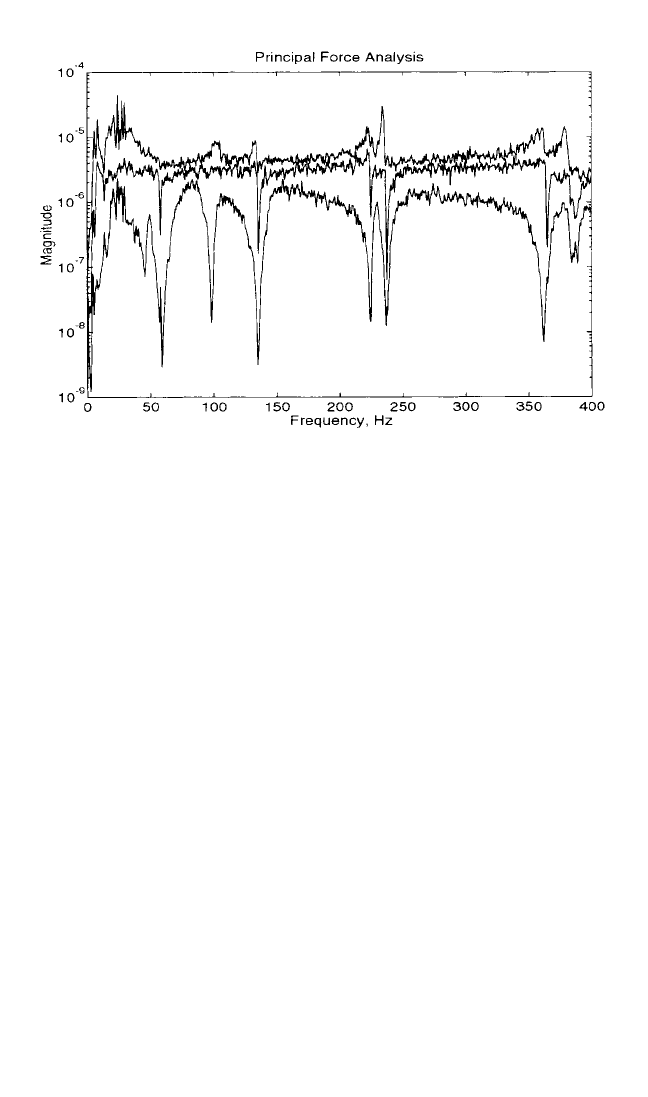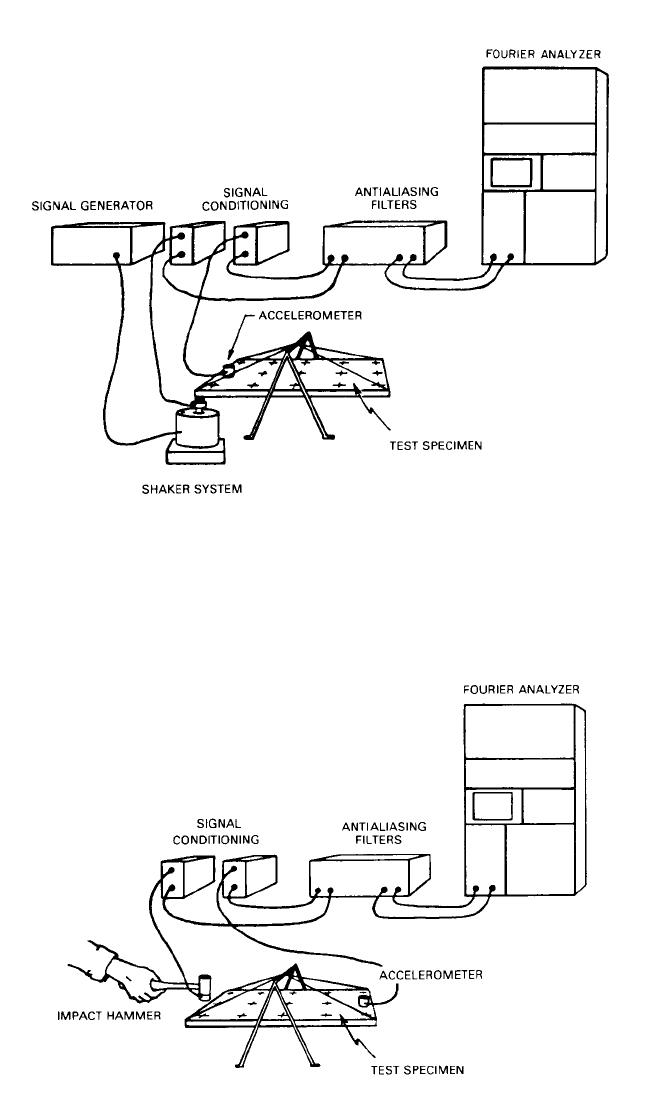Harris C.M., Piersol A.G. Harris Shock and vibration handbook
Подождите немного. Документ загружается.


ˆ
X
p
−η
p
=
N
i
q = 1
H
pq
(
ˆ
F
q
−υ
q
) (21.46)
In order to develop an estimation of the frequency response function for the multi-
ple input case, a number of averages N
avg
is used to minimize the random errors
(variance). This can be easily accomplished through use of intermediate measure-
ment of the auto- and cross-spectra as defined in Eqs. (21.33) through (21.36). Addi-
tional matrices, compared to the single input case, need to be defined. These
additional matrices are constructed from the auto- and cross-spectra previously
defined for the single input case. Each function and, therefore, each resulting matrix
is a function of frequency.
Input-output cross-spectra matrix:
X
1
X
2
WXF
11
...WXF
1N
i
[WXF] = {X}{F}
H
=
...
[F
1
* F
2
*...F
N
i
*] =
... ... ...
(21.47)
X
N
o
WXF
N
o
1
...WXF
N
o
N
i
Input cross-spectra matrix:
F
1
F
2
WFF
11
...WFF
1N
i
[WFF] = {F}{F}
H
=
...
[F
1
* F
2
*...F
N
i
*] =
... ... ...
(21.48)
F
N
i
WFF
N
i
1
...WFF
N
i
N
i
The frequency response functions can now be estimated for the three algorithms.
H
1
Algorithm: Minimize Noise on Output (h)
[H] = [WXF][WFF]
−1
(21.49)
In the experimental procedure, the input and response signals are measured,
and the averaged cross-spectra and autospectra necessary to create the [WXF],
[WFF], and [WXX] matrices are computed. The input cross-spectrum matrix must
be inverted, at least implicitly, at every frequency in the analysis range. This means
that the computational load on the measurement system is greater than for the
single input case, in which only the reciprocal of a single input autospectrum is
computed.
Equation (21.49) is valid unless the input cross-spectrum matrix [WFF] is singu-
lar for specific frequencies or frequency intervals. When this happens, the inverse of
[WFF] does not exist and Eq. (21.49) cannot be used to solve for the frequency
EXPERIMENTAL MODAL ANALYSIS 21.27
8434_Harris_21_b.qxd 09/20/2001 12:08 PM Page 21.27

response function at those frequencies or in those frequency intervals. A computa-
tional procedure that solves Eq. (21.49) for [H] must monitor the rank of the matrix
[WFF] that is to be inverted, and provide information on how to alter the input sig-
nals or use the available data when a problem exists. The current approach for eval-
uating whether the inputs are sufficiently uncorrelated at each frequency involves
determining the principal/virtual forces using principal component analysis.
10
H
2
Algorithm: Minimize Noise on Input (u)
[H] = [WXX][WFX]
−1
(21.50)
One problem with using the H
2
algorithm is that the solution for [H] can be found
directly using an inverse only when the number of inputs N
i
and number of outputs
N
o
are equal.
H
n
Algorithm: Minimize Noise on Input and Output (u and h). The solution
for [H] is found by the eigenvalue decomposition of one of the following two
matrices:
[WFF][WXF
p
]
[WFFX
p
] =
[WXF
p
]
H
WXX
p
(N
i
+ 1) × (N
i
+ 1)
(21.51)
WXX
p
[WXF
p
]
H
[WXFF
p
] =
[WXF
p
][WFF]
(N
i
+ 1) × (N
i
+ 1)
(21.52)
Therefore, the eigenvalue decomposition is
[WFFX
p
] = [V ] Λ[V ]
H
(21.53)
or
[WXFF
p
] = [V ] Λ[V ]
H
(21.54)
where Λ=diagonal matrix of eigenvalues. The solution for the pth row of the [H]
matrix is found from the eigenvector associated with the smallest (minimum) eigen-
value. Note that the size of the eigenvalue problem is N
i
+ 1 and that the eigenvalue
solution must be repeated for each frequency. The complete solution process must
be repeated for each response point X
p
.
The frequency response function associated with a single output p and all inputs
is found by normalizing the eigenvector associated with the smallest eigenvalue. If
[WFFX
p
] is used, the eigenvector associated with the smallest eigenvalue must be
normalized as follows:
H
p1
H
p2
{V}
λ
min
=
...
(21.55)
H
pN
i
−1
21.28 CHAPTER TWENTY-ONE
8434_Harris_21_b.qxd 09/20/2001 12:08 PM Page 21.28

If [WXFF
p
] is used, the eigenvector associated with the smallest eigenvalue must be
normalized as follows:
−1
H
p1
{V}
λ
min
=
H
p2
(21.56)
...
H
pN
i
The concept of the coherence function, as defined for single input measurement,
needs to be expanded to include the variety of relationships that are possible for
multiple inputs. Ordinary coherence is defined in this general sense as the correla-
tion coefficient describing the linear relationship between any two single spectra.
Great care must be taken in the interpretation of ordinary coherence when more
than one input is present. The ordinary coherence of an output with respect to an
input can be much less than unity even though the linear relationship between
inputs and outputs is valid, because of the influence of the other inputs.
4–6
The ordinary coherence function can be formulated in terms of the elements of
the matrices defined previously. The ordinary coherence function between the pth
output and the qth input can be computed from the following formula:
Ordinary coherence function:
COH
pq
=λ
pq
2
= (21.57)
where WXX
pp
= autospectrum of the output p
WFF
qq
= autospectrum of the input q
WXF
pq
= cross-spectrum between output p and input q
Partial coherence is defined as the ordinary coherence between a conditioned
output and another conditioned output, between a conditioned input and another
conditioned input, or between a conditioned input and a conditioned output. The
output and input are conditioned by removing contributions from other input(s).
The removal of the effects of the other input(s) is formulated on a linear least
squares basis.The order of removal of the inputs during “conditioning” has a definite
effect upon the partial coherence if some of the input(s) are mutually correlated.
There is a partial coherence function for every input-output, input-input, and input-
output combination for all permutations of conditioning. The usefulness of partial
coherence for experimental modal analysis is limited.
Multiple coherence is defined as the correlation coefficient describing the linear
relationship between an output and all known inputs. There is a multiple coherence
function for every output. Multiple coherence can be used to evaluate the impor-
tance of unknown contributions to each output. These unknown contributions can
be measurement noise, nonlinearities, or unknown inputs. In particular, as in the
evaluation of ordinary coherence, a low value of multiple coherence near a reso-
nance often means that leakage error is present in the frequency response function.
The formulation of the equations for the multiple coherence functions can be
simplified to the following equation:
|WXF
pq
|
2
WFF
qq
WXX
pp
EXPERIMENTAL MODAL ANALYSIS 21.29
8434_Harris_21_b.qxd 09/20/2001 12:08 PM Page 21.29

Multiple coherence function:
MCOH
p
=
N
i
q = 1
N
i
t = 1
(21.58)
where H
pq
= frequency response function for output p and input q
H
pt
= frequency response function for output p and input t
WFF
qt
= cross-spectrum between output q and output t
If the multiple coherence of the pth output is near unity, then the pth output is
well predicted from the set of inputs using the least squares frequency response
functions.
Multiple Input Force Analysis/Evaluation. Of the variety of situations that can
cause difficulties in the computation of the frequency response functions, the one
with the highest potential for trouble is the case of coherent inputs. If two of the
inputs are fully coherent, then there are no unique frequency response functions
associated with those inputs. Unfortunately, there are a number of situations where
the input cross-spectrum matrix [WFF] may be singular at specific frequencies or
frequency intervals. When this happens, the inverse of [WFF ] does not exist, and Eq.
(21.49) cannot be used to solve for the frequency response function at those fre-
quencies or in those frequency intervals. First, one of the input autospectra may be
zero in amplitude over some frequency interval. Second, two or more of the input
signals may be fully coherent over some frequency interval. Third, numerical prob-
lems which cause the computation of the inverse to be inexact may be present.
The current approach used to detect correlated inputs involves utilizing princi-
pal component analysis to determine the number of forces contributing to the
[WFF ] matrix. In this approach, a principal component analysis must be conducted
on the [WFF] matrix.
10
Principal component analysis involves an eigenvalue de-
composition of the [WFF] matrix. Since the eigenvectors of such a decomposition
are unitary, the eigenvalues should all be of approximately the same size if each of
the inputs is contributing. If one of the eigenvalues is much smaller at a particular
frequency, one of the inputs is not present or one of the inputs is correlated with the
other input(s).
[WFF] = [V ] [Λ] [V ]
H
(21.59)
where [Λ] represents the eigenvalues of the [WFF ] matrix. If any of the eigenvalues
of the [WFF] matrix are zero or insignificant, then the [WFF] matrix is singular.
Therefore, for a three-input test, the [WFF] matrix should have three eigenvalues of
approximately the same magnitude. (The number of distinct eigenvalues is equal to
the number of uncorrelated inputs.) Figure 21.11 shows the principal force plots for
a case with three inputs. At the frequencies where the third principal/virtual force
drops (lowest curve), the inputs are mutually correlated.
PRACTICAL MEASUREMENT CONSIDERATIONS
There are several factors that contribute to the quality of actual measured frequency
response function estimates. Some of the most common sources of error involve
measurement mistakes. With a proper measurement approach, most errors of this
type, such as overloading the input, extraneous signal pick-up via ground loops or
H
pq
WFF
qt
H
pt
*
WXX
pp
21.30 CHAPTER TWENTY-ONE
8434_Harris_21_b.qxd 09/20/2001 12:08 PM Page 21.30

strong electric or magnetic fields nearby, etc., can be avoided. Violations of test
assumptions are often the source of another inaccuracy and can be viewed as a meas-
urement mistake. For example, frequency response and coherence functions have
been defined as parameters of a linear system. Nonlinearities generally shift energy
from one frequency to many new frequencies, in a way which may be difficult to rec-
ognize.The result is a distortion in the estimates of the system parameters, which may
not be apparent unless the excitation is changed. One way to reduce the effect of non-
linearities is to randomize these contributions by choosing a randomly different input
signal for each of the contributing averages. Subsequent averaging reduces these con-
tributions in the same way that random noise is reduced. Another example involves
control of the system input. One requirement is to excite the system with energy at all
frequencies for which measurements are expected. It is important to be sure that the
input signal spectrum does not have frequency ranges where little energy exists.
Otherwise, coherence is very low, and the variance on the frequency response func-
tion is unacceptable.
Assuming that the system is linear, the excitation is proper, and measurement
mistakes are avoided, some amount of error and/or noise is still present in the meas-
urement process. Five different approaches can be used to reduce this error involved
in frequency response function measurements. First of all, the use of different
frequency response function estimation algorithms (H
ν
compared to H
1
) reduces the
effect of the leakage error on the estimation of the frequency response function
computation. The use of averaging significantly reduces errors of both variance and
bias and is probably the most general technique used to reduce errors in frequency
response function measurement. Selective excitation is often used to verify nonlin-
earities or randomize characteristics. In this way, bias errors due to system sources
can be reduced or controlled.The increase of frequency resolution through the zoom
fast Fourier transform improves the frequency response function estimate primarily
by reducing the leakage bias error through the use of a longer time sample. The
zoom fast Fourier transform by itself is a linear process and does not involve any
EXPERIMENTAL MODAL ANALYSIS 21.31
FIGURE 21.11 Principal (virtual) force spectra for three inputs.
8434_Harris_21_b.qxd 09/20/2001 12:08 PM Page 21.31

specific error reduction characteristics compared to a baseband fast Fourier trans-
form (FFT). Finally, the use of weighting functions (windows) is widespread, and
much has been written about their value.
4–6
Primarily, weighting functions compen-
sate for the bias error (leakage) caused by the analysis procedure.
Signal Averaging. The averaging of signals is normally viewed as a summation or
weighted summation process where each sample function has a common abscissa.
6
Normally, the designation of history is given to sample functions with the abscissa of
absolute time, and the designation of spectrum is given to sample functions with the
abscissa of absolute frequency. The spectra are normally generated by Fourier trans-
forming the corresponding history. In order to generalize and consolidate the con-
cept of signal averaging as much as possible, the case of relative time is also
considered. In this way, relative history is discussed with units of the appropriate
event rather than seconds, and a relative spectrum is the corresponding Fourier
transform with units of cycles per event. This concept of signal averaging is used
widely in structural signature analysis where the event is a revolution of a rotating
shaft.This kind of approach simplifies the application of many other concepts of sig-
nal relationships, such as Shannon’s sampling theorem and Rayleigh’s criterion of
frequency resolution.
The process of signal averaging as it applies to frequency response functions is
simplified greatly by the intrinsic uniqueness of the frequency response function.
Since the frequency response function is expressed in terms of system properties of
mass, stiffness, and damping, it is reasonable to conclude that in most realistic struc-
tures, the frequency response functions are considered to be constants, just like
mass, stiffness, and damping. This concept means that when formulating the
frequency response function using H
1
, H
2
, or H
ν
algorithms, the estimate of fre-
quency response is intrinsically unique, as long as the system is linear and the noise
can be eliminated. In general, the auto- and cross-power spectra are statistically
unique only if the input is stationary and sufficient averages are taken. Nevertheless,
the estimate of frequency response is valid whether the input is stationary, nonsta-
tionary, or deterministic.
The concept of the intrinsic uniqueness of the frequency response function also
permits a greater freedom in the testing procedure. Each function is derived as the
result of a separate test or as the result of different portions of the same continuous
test situation. In either case, the estimate of the frequency response function is the
same as long as the time-history data for the auto- and cross-power spectra that are
utilized in any computation of the frequency response or coherence function are
acquired simultaneously.
The approaches to signal averaging vary only in the relationship between the
sample functions used. Since the Fourier transform is a linear function, there is no
theoretical difference between the use of histories or spectra. (Practically, though,
there are precision considerations.) With this in mind, the signal averaging useful to
frequency response function measurements can be divided into three classifications:
●
Asynchronous
●
Synchronous
●
Cyclic
These three classifications refer to the trigger and sampling relationships between
sample functions. Asynchronous averaging describes the averaging case when each
average is acquired without a triggering event; it is sometimes referred to as free-run
21.32 CHAPTER TWENTY-ONE
8434_Harris_21_b.qxd 09/20/2001 12:08 PM Page 21.32

averaging. Synchronous averaging describes the averaging case when each average
is acquired only when an external triggering event occurs. Cyclic averaging describes
the averaging case when each average is acquired with a specific absolute time, or
phase, relationship to all previous averages. (Averaging is discussed in detail in
Chaps. 13 and 22.)
Excitation. Excitation includes any form of input that is used to create a response
in a mechanical system.This can include environmental or operational inputs as well
as the controlled force input(s) that are used in a vibration or modal analysis test. In
general, the following discussion is limited to force inputs that are measured and/or
controlled in some rigorous way.
3, 13, 14
Excitation Assumptions. The primary assumption concerning the excitation of
a linear structure is that the excitation is observable. Whenever the excitation is
measured, this assumption simply implies that the measured characteristic properly
describes the actual input characteristics. For the case of multiple inputs, the differ-
ent inputs must often be uncorrelated for the computational procedures to yield a
solution. In most cases this means only that the multiple inputs must not be perfectly
correlated at any frequency. As long as the excitation is measured, the validity of
these limited assumptions can be evaluated.
There are a number of techniques that can be used to estimate modal character-
istics from response measurements with no measurement of the excitation. If this
approach is used, the excitation assumptions are much more imposing. If the excita-
tion is not measured, estimates of modal scaling (modal mass, modal A, residues,
etc.) cannot be generated. Even when these parameters are not required, all of these
techniques have one further restriction: an assumption has to be made concerning
the characteristics of the excitation of the system. Usually, the autospectrum of the
excitation signal is assumed to be constant over the frequency interval of interest.
This is not generally practical.
Classification of Excitation. Inputs which can be used to excite a system in
order to determine frequency response functions belong to one of two classifica-
tions. The first classification is that of a random signal. Signals of this form can be
defined by their statistical properties only over some time period. Any subset of the
total time period is unique, and no explicit mathematical relationship can be formu-
lated to describe the signal. Random signals can be further classified as stationary or
nonstationary. Stationary random signals are a special case where the statistical
properties of the random signals do not vary with respect to translations with time.
Finally, stationary random signals can be classified as ergodic or nonergodic. A sta-
tionary random signal is ergodic when a time average on any particular subset of the
signal is the same for any arbitrary subset of the random signal. All random signals
which are commonly used as input signals fall into the category of ergodic, station-
ary random signals.
The second classification of inputs which can be used to excite a system in order
to determine frequency response functions is that of a deterministic signal. Signals of
this form can be represented in an explicit mathematical relationship. Deterministic
signals are further divided into periodic and nonperiodic classifications. The most
common inputs in the periodic deterministic signal designation are sinusoidal in
nature, while the most common inputs in the nonperiodic deterministic designation
are transient in form.
The choice of input to be used to excite a system in order to determine frequency
response functions depends upon the characteristics of the system, the characteristics
of the parameter estimation, and the expected utilization of the data. The characteri-
zation of the system is primarily concerned with the linearity of the system. As long
EXPERIMENTAL MODAL ANALYSIS 21.33
8434_Harris_21_b.qxd 09/20/2001 12:08 PM Page 21.33

as the system is linear, all input forms should give the same expected value. Naturally,
though, all real systems have some degree of nonlinearity. Deterministic input signals
result in frequency response functions that are dependent upon the signal level and
type. A set of frequency response functions for different signal levels can be used to
document the nonlinear characteristics of the system. Random input signals, in the
presence of nonlinearities, result in a frequency response function that represents the
best linear representation of the nonlinear characteristics for a given level of random
signal input. For small nonlinearities, use of a random input does not differ greatly
from the use of a deterministic input.
The characterization of the parameter estimation is primarily concerned with the
type of mathematical model being used to represent the frequency response func-
tion. Generally, the model is a linear summation based upon the modal parameters
of the system. Unless the mathematical representation of all nonlinearities is known,
the parameter estimation process cannot properly weight the frequency response
function data to include nonlinear effects. For this reason, random input signals are
regularly used to obtain the best linear estimate of the frequency response function
when a parameter estimation process using a linear model is to be utilized.
The expected utilization of the data is concerned with the degree of detailed
information required by any postprocessing task. For experimental modal analysis,
this can range from implicit modal vectors needed for troubleshooting to explicit
modal vectors used in an orthogonality check. As more detail is required, input sig-
nals, both random and deterministic, need to match the system characteristics and
parameter estimation characteristics more closely. In all possible uses of frequency
response function data, the conflicting requirements of the need for accuracy, equip-
ment availability, testing time, and testing cost normally reduce the possible choices
of input signal.
With respect to the reduction of the variance and bias errors of the frequency
response function, random or deterministic signals can be utilized most effectively if
the signals are periodic with respect to the sample period or totally observable with
respect to the sample period. If either of these criteria is satisfied, regardless of sig-
nal type, the predominant bias error, leakage, is eliminated. If these criteria are not
satisfied, the leakage error may become significant. In either case, the variance error
is a function of the signal-to-noise ratio and the amount of averaging.
Many signals are appropriate for use in experimental modal analysis. Some of the
most commonly used signals are described in the following sections. For those exci-
tation signals that require the use of a shaker, Fig. 21.12 shows a typical test configu-
ration; Fig. 21.13 shows a typical test configuration when an impact form of
excitation is to be used. The advantages and disadvantages of each excitation signal
are summarized in Table 21.2.
Slow swept sine. The slow swept sine signal is a periodic deterministic signal
with a frequency that is an integer multiple of the FFT frequency increment. Suf-
ficient time is allowed in the measurement procedure for any transient response
to the changes in frequency to decay, so that the resultant input and response his-
tories are periodic with respect to the sample period. Therefore, the total time
needed to compute an entire frequency response function is a function of the
number of frequency increments required and the system damping.
Periodic chirp. The periodic chirp is a fast swept sine signal that is a periodic
deterministic signal and is formulated by sweeping a sine signal up or down
within a frequency band of interest during a single sample period. Normally, the
fast swept sine signal is made up of only integer multiples of the FFT frequency
increment. This signal is repeated without change so that the input and output
histories are periodic with respect to the sample period.
21.34 CHAPTER TWENTY-ONE
8434_Harris_21_b.qxd 09/20/2001 12:08 PM Page 21.34

Impact (impulse). The impact signal is a transient deterministic signal which is
formed by applying an input pulse lasting only a very small part of the sample
period to a system.The width, height, and shape of this pulse determine the usable
spectrum of the impact. Briefly, the width of the pulse determines the frequency
spectrum, while the height and shape of the pulse control the level of the spec-
EXPERIMENTAL MODAL ANALYSIS 21.35
FIGURE 21.12 Typical fixed-input modal test configuration: shaker.
FIGURE 21.13 Typical fixed-response modal test configuration: impact hammer.
8434_Harris_21_b.qxd 09/20/2001 12:08 PM Page 21.35

TABLE 21.2 Characteristics of Excitation Signals Used in Experimental Modal Analysis
Slow
swept Periodic Step Pure Pseudo- Periodic Burst
sine chirp Impact relaxation random random random random
Minimize leakage Yes/No Yes Yes Yes No Yes Yes Yes
Signal-to-noise ratio Very High Low Low Fair Fair Fair Fair
high
RMS-to-peak ratio High High Low Low Fair Fair Fair Fair
Test measurement time Very Very Very Very Good Very Long Good
long short short short short
Controlled frequency Yes* Yes* No No Yes* Yes* Yes* Yes*
content
Controlled amplitude Yes* Yes* No Yes/No No Yes* Yes* No
content
Removes distortion No No No No Yes No Yes Yes
Characterize Yes Yes No No No Yes No No
nonlinearity
* Special hardware required.
21.36
8434_Harris_21_b.qxd 09/20/2001 12:08 PM Page 21.36
